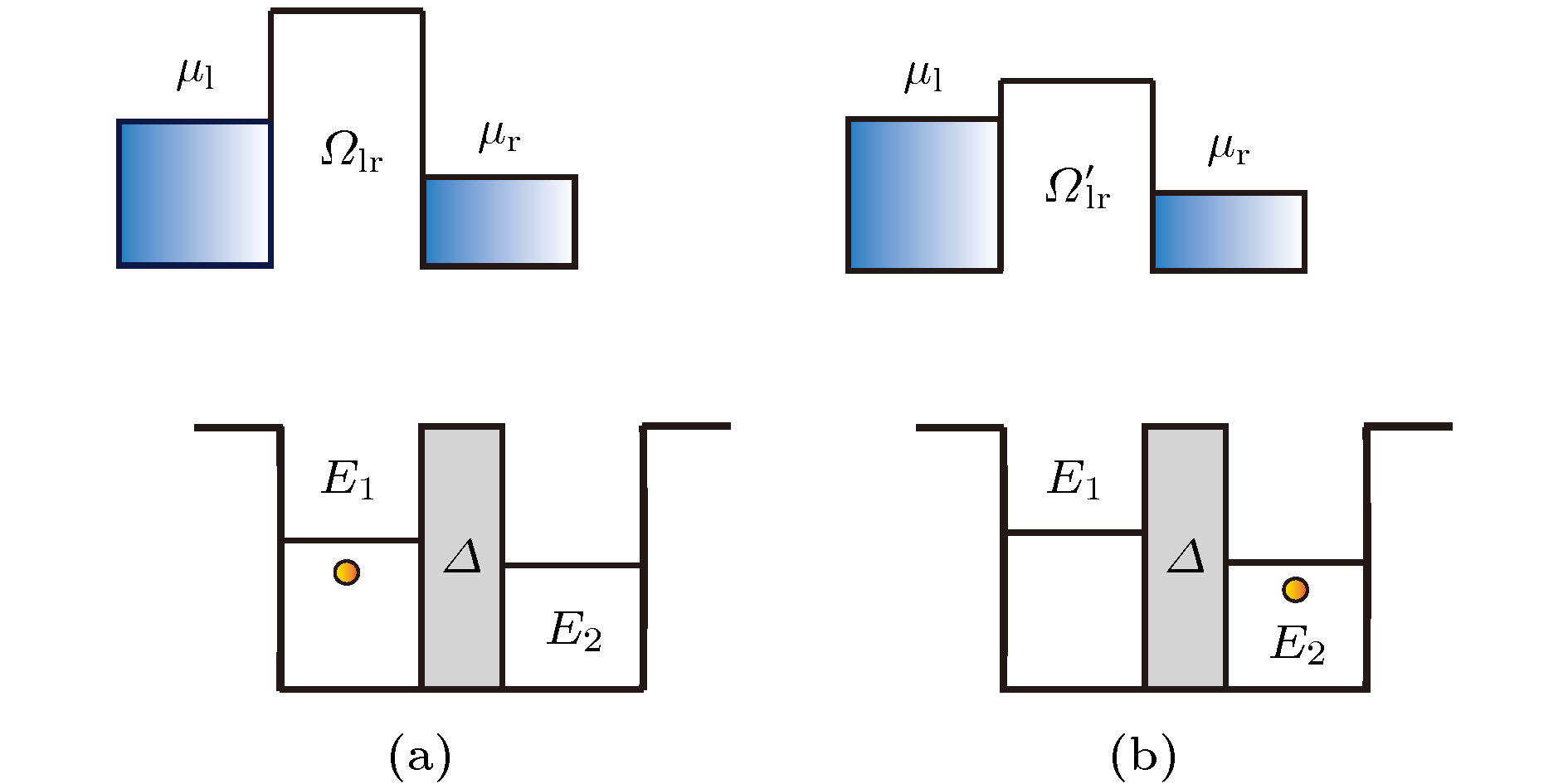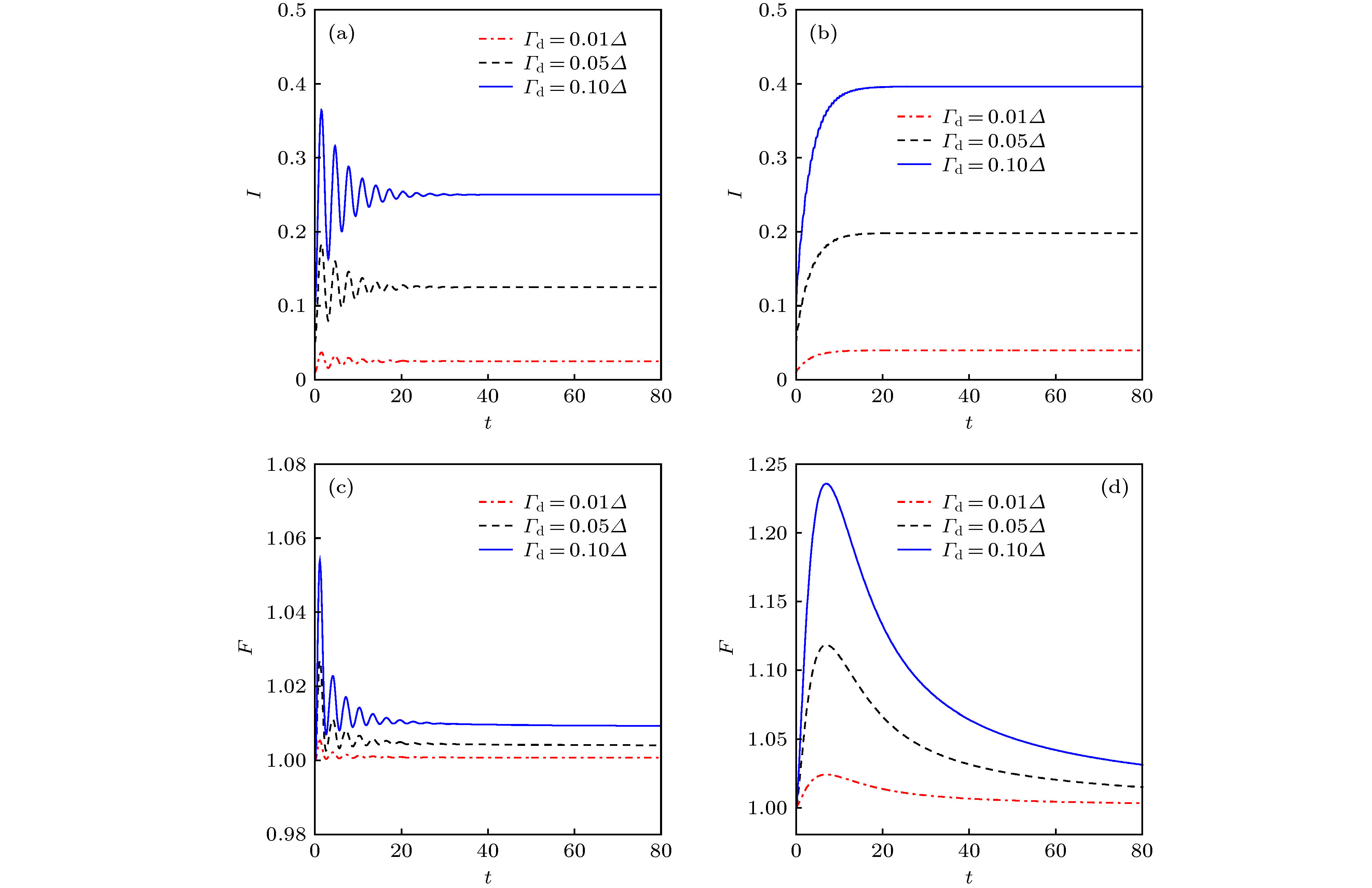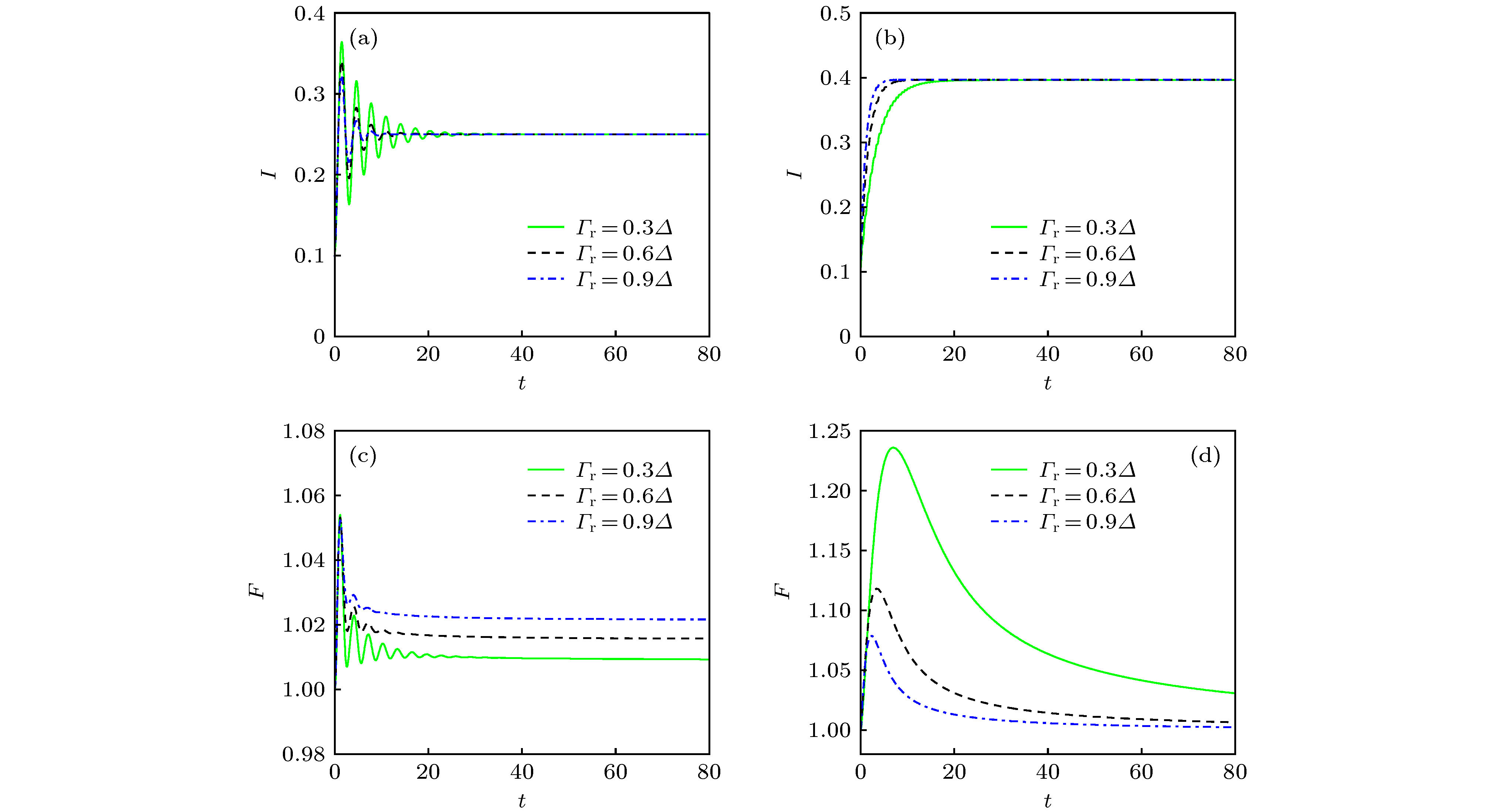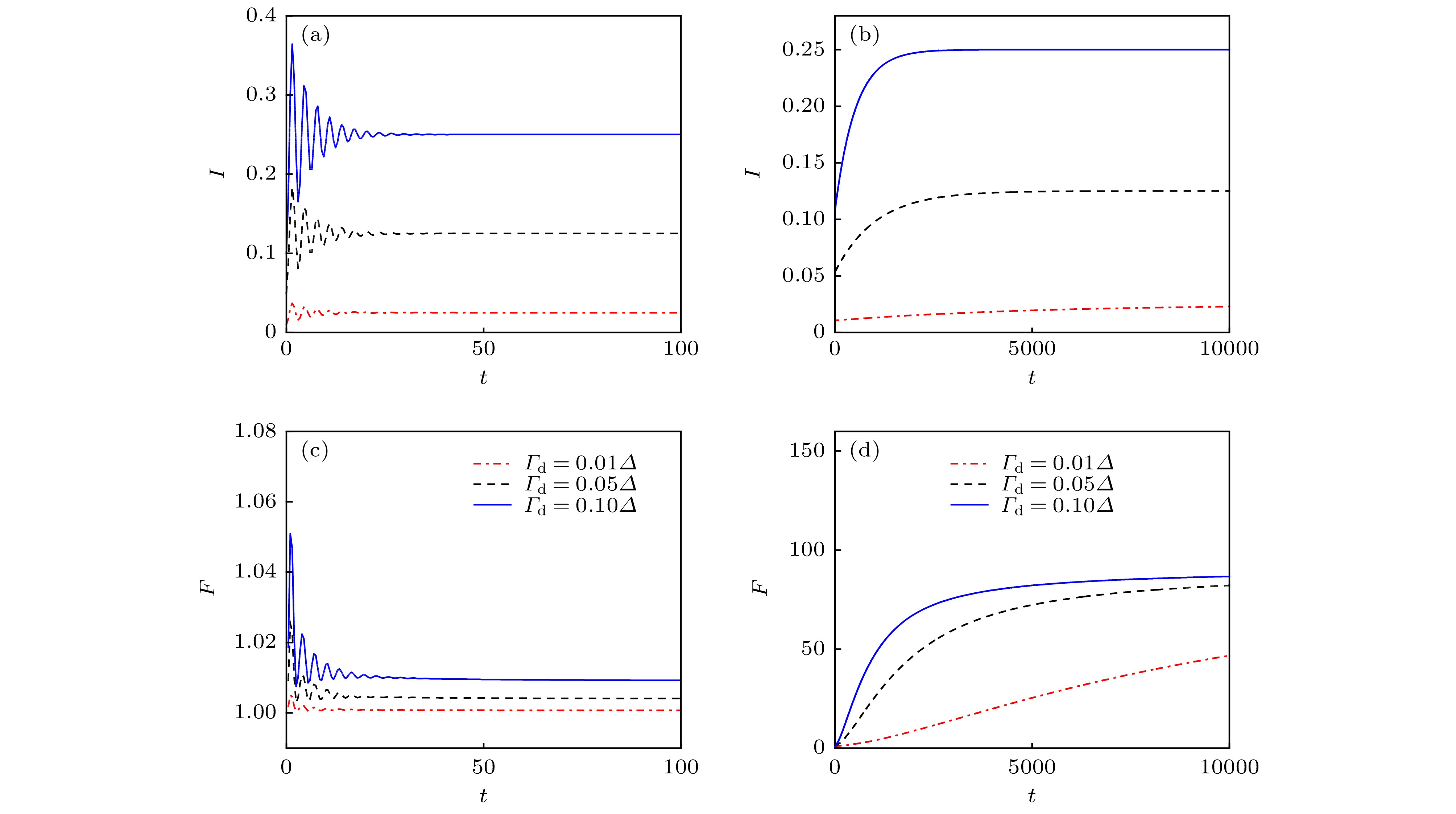-
基于量子点接触探测器(QPC)理论上研究了双量子点(DQD)系统在耗散环境和纯退相环境影响下的电子转移特性. 结果表明, 耗散环境中探测器导致的退相干会增大平均电流和Fano factor随时间演化的值, 并观察到量子芝诺效应的存在. 在对称的DQD情况下, 弛豫减小了平均电流随时间演化的震荡振幅. 在非对称的DQD情况下, 弛豫降低了Fano factor随时间演化的峰值. 纯退相环境中测量会阻碍共隧穿过程中不同电流通道之间的转换, 导致Fano factor的极高值. 在对称的DQD情况下, 增大纯退相速率会提高Fano factor. 在非对称的DQD情况下, 动力学随时间的演化对纯退相环境不敏感. 另外, 还发现探测器内n个电子的转移几率只受QPC与DQD耦合的影响. 我们的结论可以为实验工作者研究电子输运特性提供理论参考.We theoretically study the electron transfer properties of a double quantum dot system in dissipative and pure dephasing environments based on a quantum dot contact detector. Theoretical results show that in the dissipative environment, the decoherence caused by the detector would increase the stable value of the average current and Fano factor as functions of time. Meanwhile, we find the existence of the quantum Zeno effect during the process of dynamical evolution. In the case of symmetric DQD, the relaxation caused by the dissipative environment would decrease the amplitude of the average current with time evolution and increase the value of the Fano factor in the long time limit. In the case of asymmetric DQD, the relaxation reduces the peak value of Fano factor over time. In the pure dephasing environment, we find that the frequent measurement would hinder the switch between different current channels during the cotunneling process. This results in a high value of Fano factor. In the case of symmetric DQD, increasing the pure dephasing rate would improve the value of Fano factor. In the case of asymmetric DQD, the dynamical evolution with time is not sensitive to the pure dephasing rate. In addition, it is indicated that the transfer probability of electron in the detector is only affected by the coupling between QPC and DQD. The environments have no effect on the transfer of a single electron in the detector. Our theoretical results provide theoretical references for experimental researchers to study the electron transport properties.
-
Keywords:
- double quantum dot /
- quantum point contact /
- quantum decoherence /
- shot noise
[1] Gurvitz S A, Fedichkin L, Mozyrsky D, Berman G P 2003 Phys. Rev. Lett. 91 066801
 Google Scholar
Google Scholar
[2] Kang L S, Zhang Y H, Xu X L, Tang X 2017 Phys. Rev. B 96 235417
 Google Scholar
Google Scholar
[3] 孙峰, 刘然, 索雨晴, 牛乐乐, 傅焕俨, 季文芳, 李宗良 2019 物理学报 68 178502
 Google Scholar
Google Scholar
Sun F, Liu R, Suo Y Q, Niu L L, Fu H Y, Ji W F, Li Z L 2019 Acta Phys. Sin. 68 178502
 Google Scholar
Google Scholar
[4] 赵文垒, 王建忠, 豆福全 2012 物理学报 61 240302
 Google Scholar
Google Scholar
Zhao W L, Wang J Z, Dou F Q 2012 Acta Phys. Sin. 61 240302
 Google Scholar
Google Scholar
[5] Cui P, Li X Q, Shao J S, Yan Y J 2006 Phys. Lett. A 357 449
 Google Scholar
Google Scholar
[6] Gurvitz S A, Mozyrsky D 2008 Phys. Rev. B 77 075325
 Google Scholar
Google Scholar
[7] Zhao G P, Zhang Y H, Cai X J, Xu X L, Kang L S 2016 Physica E 84 10
 Google Scholar
Google Scholar
[8] Cai X J 2019 Entropy 21 1040
 Google Scholar
Google Scholar
[9] Li Z L, Bi J J, Liu R, Yi X H, Fu H Y, Sun F, Wei M Z, Wang C K 2017 Chin. Phys. B 26 098508
 Google Scholar
Google Scholar
[10] Cai X J, Zheng Y J 2018 J. Chem. Phys. 149 094107
 Google Scholar
Google Scholar
[11] Alexander S, Uttam S, Shekhar D H, Nath B M, Gerardo A 2015 Phys. Rev. Lett. 115 020403
 Google Scholar
Google Scholar
[12] 李保民, 胡明亮, 范桁 2019 物理学报 68 030304
 Google Scholar
Google Scholar
Li B M, Hu M L, Fan H 2019 Acta Phys. Sin. 68 030304
 Google Scholar
Google Scholar
[13] Xu P, Wang D, Ye L 2013 Chin. Phys. B 22 100306
 Google Scholar
Google Scholar
[14] Zhang Y H, Kang L S, Xu X L, Tang X, Li H B, Cai X J 2017 Mod. Phys. Lett. B 31 1730004
 Google Scholar
Google Scholar
[15] Zheng S B, Guo G C 2000 Phys. Rev. Lett. 85 2392
 Google Scholar
Google Scholar
[16] Gurvitz S A 1997 Phys. Rev. B 56 15215
 Google Scholar
Google Scholar
[17] Cai X J, Zheng Y J 2016 Phys. Rev. A 94 042110
 Google Scholar
Google Scholar
[18] Sun S N, Zheng Y J 2019 Phys. Rev. Lett. 123 180403
 Google Scholar
Google Scholar
[19] Cai X J, Zheng Y J 2017 Phys. Rev. A 95 052104
 Google Scholar
Google Scholar
[20] Cai X J, Meng R X, Zhang Y H, Wang L F 2019 Europhys. Lett. 125 30007
 Google Scholar
Google Scholar
[21] 尹永琦, 马佳宁, 李华, 王选章, 贺泽龙 2009 物理学报 58 4162
 Google Scholar
Google Scholar
Yin Y Q, Ma J N, Li H, Wang X Z, He Z L 2009 Acta Phys. Sin. 58 4162
 Google Scholar
Google Scholar
[22] Yang L W, Xia Y J 2016 Chin. Phys. B 25 110303
 Google Scholar
Google Scholar
[23] 杨军, 武文远, 龚艳春 2008 物理学报 57 448
 Google Scholar
Google Scholar
Yang J, Wu W Y, Gong Y C 2008 Acta Phys. Sin. 57 448
 Google Scholar
Google Scholar
[24] Li X Q, Cui P, Yan Y J 2005 Phys. Rev. Lett. 94 066803
 Google Scholar
Google Scholar
[25] Ouyang S H, Lam C H, You J Q 2010 Phys. Rev. B 81 075301
 Google Scholar
Google Scholar
[26] 栗军, 刘玉, 平婧, 叶银, 李新奇 2012 物理学报 61 137202
 Google Scholar
Google Scholar
Li J, Liu Y, Ping J, Ye Y, Li X Q 2012 Acta Phys. Sin. 61 137202
 Google Scholar
Google Scholar
[27] Aguado R, Brandes T 2004 Phys. Rev. Lett. 92 206601
 Google Scholar
Google Scholar
[28] Du L, Wu J H, Artoni M, Rocca G C 2019 Phys. Rev. A 100 052102
 Google Scholar
Google Scholar
[29] Ford G W, Lewis J T, O'Connell R F 2001 Phys. Rev. A 64 032101
 Google Scholar
Google Scholar
[30] Korotkov A N, Averin D V 2001 Phys. Rev. B 64 165310
 Google Scholar
Google Scholar
[31] Korotkov A N 2001 Phys. Rev. B 63 085312
 Google Scholar
Google Scholar
[32] Xu C R, Vavilov M G 2013 Phys. Rev. B 88 195307
 Google Scholar
Google Scholar
[33] Gurvitz S A 2019 J. Phys. A: Math. Theor. 52 175301
 Google Scholar
Google Scholar
[34] Levitov L S, Lesovik G B 1993 JETP Lett. 58 230
[35] Levitov L S, Lee H, Lesovik G B 1996 J. Math. Phys. 37 4845
 Google Scholar
Google Scholar
[36] Bagrets D A, Nazarov Yu V 2003 Phys. Rev. B 67 085316
 Google Scholar
Google Scholar
[37] Flindt C, Novotný T, Braggio A, Jauho A 2010 Phys. Rev. B 82 155407
 Google Scholar
Google Scholar
[38] Novotný T, Donarini A, Flindt C, Jauho A 2004 Phys. Rev. Lett. 92 248302
 Google Scholar
Google Scholar
[39] Iannaccone G, Lombardi G, Macucci M, Pellegrini B 1998 Phys. Rev. Lett. 80 1054
 Google Scholar
Google Scholar
[40] Kießlich G, Schöll E, Brandes T, Hohls F, Haug R J 2007 Phys. Rev. Lett. 99 206602
 Google Scholar
Google Scholar
[41] Olsen M K, Corney J F 2013 Phys. Rev. A 87 033839
 Google Scholar
Google Scholar
[42] 鹿博, 韩成银, 庄敏, 柯勇贯, 黄嘉豪, 李朝红 2019 物理学报 68 040306
 Google Scholar
Google Scholar
Lu B, Han C Y, Zhuang M, Ke Y G, Huang J H, Li C H 2019 Acta Phys. Sin. 68 040306
 Google Scholar
Google Scholar
[43] Albert M, Haack G, Flindt C, Büttiker M 2012 Phys. Rev. Lett. 108 186806
 Google Scholar
Google Scholar
[44] Tang G M, Xu F M, Wang J 2014 Phys. Rev. B 89 205310
 Google Scholar
Google Scholar
[45] Gurvitz S A, Prager Y S 1996 Phys. Rev. B 53 15932
 Google Scholar
Google Scholar
[46] Bagrets D A, Utsumi Y, Golubev D S, Schön G 2006 Fortschr. Phys. 54 917
 Google Scholar
Google Scholar
[47] Emary C, Marcos D, Aguado R, Brandes T 2007 Phys. Rev. B 76 161404
 Google Scholar
Google Scholar
[48] Zheng Y J, Brown F L H 2003 Phys. Rev. Lett. 90 238305
 Google Scholar
Google Scholar
[49] Luo J Y, Jiao H J, Shen Y, Cen G, He X L, Wang C R 2011 J. Phys. Condens. Matter 23 145301
 Google Scholar
Google Scholar
[50] Pfeifer P 1982 Phys. Rev. A 26 701
 Google Scholar
Google Scholar
[51] Gurvitz S A 2003 Quantum. Inf. Process. 2 15
 Google Scholar
Google Scholar
[52] Carmi A, Oreg Y 2012 Phys. Rev. B 85 045325
 Google Scholar
Google Scholar
[53] Kok P, Munro W J, Nemoto K, Ralph T C, Dowling J P, Milburn G J 2007 Rev. Mod. Phys. 79 135
 Google Scholar
Google Scholar
[54] Sukhorukov E V, Burkard G, Loss D 2001 Phys. Rev. B 63 125315
 Google Scholar
Google Scholar
[55] Xue H B, Zhang Z X, Fei H M 2012 Eur. Phys. J. B 85 336
 Google Scholar
Google Scholar
[56] Thielmann A, Hettler M H, König J, Schön G 2005 Phys. Rev. Lett. 95 146806
 Google Scholar
Google Scholar
[57] Flindt C, Novotný T, Jauho A P 2004 Phys. Rev. B 70 205334
 Google Scholar
Google Scholar
-
图 1 量子点接触探测器测量的双量子点 (a)电子处在左侧的量子点会增大探测器的势垒, 减小探测器中电子的隧穿几率; (b) 电子处在右侧量子点会减小探测器势垒, 增大探测器中电子的隧穿几率.
$\mu_{\rm l}$ 和$\mu_{\rm r}$ 表示探测器左侧和右侧的电子库,$V=\mu_{\rm l}-\mu_{\rm r}$ 是探测器的偏压.$\varOmega_{ {lr}}$ 和$\varOmega^{'}_{ {lr}}$ 分别是电子处于左侧和右侧量子点时探测器两端能级$E_{\rm l}$ 与$E_{\rm r}$ 之间的跳跃振幅Fig. 1. A double quantum dot detected by a quantum point contact: (a) The electron occupies the left quantum dot increases the potential barrier of the detector and reduces the tunneling of electrons in the detector; (b) the electron occupies the right quantum dot reduces the potential barrier of the detector and increases the tunneling of electrons in the detector.
$\mu_{\rm l}$ and$\mu_{\rm r}$ represent the chemical potentials in the left and right reservoirs of the detector,$V=\mu_{\rm l}-\mu_{\rm r}$ is the bias voltage of the detector,$\varOmega_{{lr}}$ and$\varOmega^{'}_{ {lr}}$ are the hopping amplitudes between the states$E_{\rm l}$ and$E_{\rm r}$ of the detector for electron in the left and right quantum dots, respectively.图 2 耗散环境中不同退相干速率影响下平均电流和Fano factor随时间的演化 (a) 对称DQD(
$\varepsilon=0$ )时的平均电流; (b) 非对称DQD($\varepsilon=10\varDelta$ )时的平均电流; (c) 对称DQD($\varepsilon=0$ )时的Fano factor; (d) 非对称DQD($\varepsilon=10\varDelta$ )时的Fano factorFig. 2. Distributions of the average current and the Fano factor versus t for different values of
$\varGamma_{\rm d}$ in the dissipative environment: (a) The average current in symmetric case ($\varepsilon=0$ ); (b) the average current in asymmetric case ($\varepsilon=10\varDelta$ ); (c) the Fano factor in symmetric case ($\varepsilon=0$ ); (d) the Fano factor in asymmetric case ($\varepsilon=10\varDelta$ ).图 3 耗散环境中不同弛豫速率影响下平均电流和Fano factor随时间的演化 (a) 对称DQD(
$\varepsilon=0$ )时的平均电流; (b) 非对称DQD($\varepsilon=10\varDelta$ )时的平均电流; (c) 对称DQD($\varepsilon=0$ )时的Fano factor; (d) 非对称DQD($\varepsilon=10\varDelta$ )时的Fano factorFig. 3. Distributions of the average current and the Fano factor versus t for different values of
$\varGamma_{\rm r}$ in the dissipative environment: (a) The average current in symmetric case ($\varepsilon=0$ ); (b) the average current in asymmetric case ($\varepsilon=10\varDelta$ ); (c) the Fano factor in symmetric case ($\varepsilon=0$ ); (d) the Fano factor in asymmetric case ($\varepsilon=10\varDelta$ ).图 4 耗散环境中不同退相干速率和弛豫速率影响下电子转移几率随时间的演化,
$\varepsilon=0$ (a) 不同退相干速率下转移$0$ 个电子的几率; (b) 不同弛豫速率下转移$0$ 个电子的几率; (c) 不同退相干速率下转移$1$ 个电子的几率; (d) 不同弛豫速率下转移$1$ 个电子的几率; (e) 不同退相干速率下转移$2$ 个电子的几率; (f) 不同弛豫速率下转移$2$ 个电子的几率Fig. 4. Distribution of the electron transfer probability versus t for different values of
$\varGamma_{\rm d}$ and$\varGamma_{\rm r}$ in the dissipative environment,$\varepsilon=0$ : (a) The probability of$0$ electron transfer at different values of$\varGamma_{\rm d}$ ; (b) the probability of$0$ electron transfer at different values of$\varGamma_{\rm r}$ ; (c) the probability of$1$ electron transfer at different values of$\varGamma_{\rm d}$ ; (d) the probability of$1$ electron transfer at different values of$\varGamma_{\rm r}$ ); (e) the probability of$2$ electrons transfer at different values of$\varGamma_{\rm d}$ ; (f) the probability of$2$ electrons transfer at different values of$\varGamma_{\rm r}$ .图 5 纯退相环境中不同退相干速率影响下平均电流和Fano factor随时间的分布 (a) 对称DQD(
$\varepsilon=0$ )时的平均电流; (b) 非对称DQD($\varepsilon=10\varDelta$ )时的平均电流; (c) 对称DQD($\varepsilon=0$ )时的Fano factor; (d) 非对称DQD($\varepsilon=10\varDelta$ )时的Fano factorFig. 5. Distributions of the average current and the Fano factor versus t for different values of
$\varGamma_{\rm d}$ in the pure dephasing environment: (a) The average current in symmetric case ($\varepsilon=0$ ); (b) the average current in asymmetric case ($\varepsilon=10\varDelta$ ); (c) the Fano factor in symmetric case ($\varepsilon=0$ ); (d) the Fano factor in asymmetric case ($\varepsilon=10\varDelta$ ).图 6 纯退相环境中不同纯退相速率影响下平均电流和Fano factor随时间的演化 (a) 对称DQD(
$\varepsilon=0$ )时的平均电流; (b) 非对称DQD($\varepsilon=10\varDelta$ )时的平均电流; (c) 对称DQD($\varepsilon=0$ )时的Fano factor; (d) 非对称DQD($\varepsilon=10\varDelta$ )时的Fano factorFig. 6. Distributions of the average current and the Fano factor versus t for different values of
$\varGamma_{\phi}$ in the pure dephasing environment: (a) The average current in symmetric case ($\varepsilon=0$ ); (b) the average current in asymmetric case ($\varepsilon=10\varDelta$ ); (c) the Fano factor in symmetric case ($\varepsilon=0$ ); (d) the Fano factor in asymmetric case ($\varepsilon=10\varDelta$ ).图 7 纯退相环境中不同退相干速率和纯退相速率影响下电子转移几率随时间的演化,
$\varepsilon=10\varDelta$ (a) 不同退相干速率下转移0个电子的几率; (b) 不同纯退相速率下转移0个电子的几率; (c) 不同退相干速率下转移1个电子的几率; (d) 不同纯退相速率下转移1个电子的几率; (e) 不同退相干速率下转移2个电子的几率; (f) 不同纯退相速率下转移2个电子的几率Fig. 7. Distribution of the electron transfer probability versus t for different values of
$\varGamma_{\rm d}$ and$\varGamma_{\phi}$ in the pure dephasing environment,$\varepsilon=0$ : (a) The probability of 0 electron transfer at different values of$\varGamma_{\rm d}$ ; (b) the probability of 0 electron transfer at different values of$\varGamma_{\phi}$ ; (c) the probability of 1 electron transfer at different values of$\varGamma_{\rm d}$ ; (d) the probability of 1 electron transfer at different values of$\varGamma_{\phi}$ ); (e) the probability of 2 electrons transfer at different values of$\varGamma_{\rm d}$ ; (f) the probability of 2 electrons transfer at different values of$\varGamma_{\phi}$ . -
[1] Gurvitz S A, Fedichkin L, Mozyrsky D, Berman G P 2003 Phys. Rev. Lett. 91 066801
 Google Scholar
Google Scholar
[2] Kang L S, Zhang Y H, Xu X L, Tang X 2017 Phys. Rev. B 96 235417
 Google Scholar
Google Scholar
[3] 孙峰, 刘然, 索雨晴, 牛乐乐, 傅焕俨, 季文芳, 李宗良 2019 物理学报 68 178502
 Google Scholar
Google Scholar
Sun F, Liu R, Suo Y Q, Niu L L, Fu H Y, Ji W F, Li Z L 2019 Acta Phys. Sin. 68 178502
 Google Scholar
Google Scholar
[4] 赵文垒, 王建忠, 豆福全 2012 物理学报 61 240302
 Google Scholar
Google Scholar
Zhao W L, Wang J Z, Dou F Q 2012 Acta Phys. Sin. 61 240302
 Google Scholar
Google Scholar
[5] Cui P, Li X Q, Shao J S, Yan Y J 2006 Phys. Lett. A 357 449
 Google Scholar
Google Scholar
[6] Gurvitz S A, Mozyrsky D 2008 Phys. Rev. B 77 075325
 Google Scholar
Google Scholar
[7] Zhao G P, Zhang Y H, Cai X J, Xu X L, Kang L S 2016 Physica E 84 10
 Google Scholar
Google Scholar
[8] Cai X J 2019 Entropy 21 1040
 Google Scholar
Google Scholar
[9] Li Z L, Bi J J, Liu R, Yi X H, Fu H Y, Sun F, Wei M Z, Wang C K 2017 Chin. Phys. B 26 098508
 Google Scholar
Google Scholar
[10] Cai X J, Zheng Y J 2018 J. Chem. Phys. 149 094107
 Google Scholar
Google Scholar
[11] Alexander S, Uttam S, Shekhar D H, Nath B M, Gerardo A 2015 Phys. Rev. Lett. 115 020403
 Google Scholar
Google Scholar
[12] 李保民, 胡明亮, 范桁 2019 物理学报 68 030304
 Google Scholar
Google Scholar
Li B M, Hu M L, Fan H 2019 Acta Phys. Sin. 68 030304
 Google Scholar
Google Scholar
[13] Xu P, Wang D, Ye L 2013 Chin. Phys. B 22 100306
 Google Scholar
Google Scholar
[14] Zhang Y H, Kang L S, Xu X L, Tang X, Li H B, Cai X J 2017 Mod. Phys. Lett. B 31 1730004
 Google Scholar
Google Scholar
[15] Zheng S B, Guo G C 2000 Phys. Rev. Lett. 85 2392
 Google Scholar
Google Scholar
[16] Gurvitz S A 1997 Phys. Rev. B 56 15215
 Google Scholar
Google Scholar
[17] Cai X J, Zheng Y J 2016 Phys. Rev. A 94 042110
 Google Scholar
Google Scholar
[18] Sun S N, Zheng Y J 2019 Phys. Rev. Lett. 123 180403
 Google Scholar
Google Scholar
[19] Cai X J, Zheng Y J 2017 Phys. Rev. A 95 052104
 Google Scholar
Google Scholar
[20] Cai X J, Meng R X, Zhang Y H, Wang L F 2019 Europhys. Lett. 125 30007
 Google Scholar
Google Scholar
[21] 尹永琦, 马佳宁, 李华, 王选章, 贺泽龙 2009 物理学报 58 4162
 Google Scholar
Google Scholar
Yin Y Q, Ma J N, Li H, Wang X Z, He Z L 2009 Acta Phys. Sin. 58 4162
 Google Scholar
Google Scholar
[22] Yang L W, Xia Y J 2016 Chin. Phys. B 25 110303
 Google Scholar
Google Scholar
[23] 杨军, 武文远, 龚艳春 2008 物理学报 57 448
 Google Scholar
Google Scholar
Yang J, Wu W Y, Gong Y C 2008 Acta Phys. Sin. 57 448
 Google Scholar
Google Scholar
[24] Li X Q, Cui P, Yan Y J 2005 Phys. Rev. Lett. 94 066803
 Google Scholar
Google Scholar
[25] Ouyang S H, Lam C H, You J Q 2010 Phys. Rev. B 81 075301
 Google Scholar
Google Scholar
[26] 栗军, 刘玉, 平婧, 叶银, 李新奇 2012 物理学报 61 137202
 Google Scholar
Google Scholar
Li J, Liu Y, Ping J, Ye Y, Li X Q 2012 Acta Phys. Sin. 61 137202
 Google Scholar
Google Scholar
[27] Aguado R, Brandes T 2004 Phys. Rev. Lett. 92 206601
 Google Scholar
Google Scholar
[28] Du L, Wu J H, Artoni M, Rocca G C 2019 Phys. Rev. A 100 052102
 Google Scholar
Google Scholar
[29] Ford G W, Lewis J T, O'Connell R F 2001 Phys. Rev. A 64 032101
 Google Scholar
Google Scholar
[30] Korotkov A N, Averin D V 2001 Phys. Rev. B 64 165310
 Google Scholar
Google Scholar
[31] Korotkov A N 2001 Phys. Rev. B 63 085312
 Google Scholar
Google Scholar
[32] Xu C R, Vavilov M G 2013 Phys. Rev. B 88 195307
 Google Scholar
Google Scholar
[33] Gurvitz S A 2019 J. Phys. A: Math. Theor. 52 175301
 Google Scholar
Google Scholar
[34] Levitov L S, Lesovik G B 1993 JETP Lett. 58 230
[35] Levitov L S, Lee H, Lesovik G B 1996 J. Math. Phys. 37 4845
 Google Scholar
Google Scholar
[36] Bagrets D A, Nazarov Yu V 2003 Phys. Rev. B 67 085316
 Google Scholar
Google Scholar
[37] Flindt C, Novotný T, Braggio A, Jauho A 2010 Phys. Rev. B 82 155407
 Google Scholar
Google Scholar
[38] Novotný T, Donarini A, Flindt C, Jauho A 2004 Phys. Rev. Lett. 92 248302
 Google Scholar
Google Scholar
[39] Iannaccone G, Lombardi G, Macucci M, Pellegrini B 1998 Phys. Rev. Lett. 80 1054
 Google Scholar
Google Scholar
[40] Kießlich G, Schöll E, Brandes T, Hohls F, Haug R J 2007 Phys. Rev. Lett. 99 206602
 Google Scholar
Google Scholar
[41] Olsen M K, Corney J F 2013 Phys. Rev. A 87 033839
 Google Scholar
Google Scholar
[42] 鹿博, 韩成银, 庄敏, 柯勇贯, 黄嘉豪, 李朝红 2019 物理学报 68 040306
 Google Scholar
Google Scholar
Lu B, Han C Y, Zhuang M, Ke Y G, Huang J H, Li C H 2019 Acta Phys. Sin. 68 040306
 Google Scholar
Google Scholar
[43] Albert M, Haack G, Flindt C, Büttiker M 2012 Phys. Rev. Lett. 108 186806
 Google Scholar
Google Scholar
[44] Tang G M, Xu F M, Wang J 2014 Phys. Rev. B 89 205310
 Google Scholar
Google Scholar
[45] Gurvitz S A, Prager Y S 1996 Phys. Rev. B 53 15932
 Google Scholar
Google Scholar
[46] Bagrets D A, Utsumi Y, Golubev D S, Schön G 2006 Fortschr. Phys. 54 917
 Google Scholar
Google Scholar
[47] Emary C, Marcos D, Aguado R, Brandes T 2007 Phys. Rev. B 76 161404
 Google Scholar
Google Scholar
[48] Zheng Y J, Brown F L H 2003 Phys. Rev. Lett. 90 238305
 Google Scholar
Google Scholar
[49] Luo J Y, Jiao H J, Shen Y, Cen G, He X L, Wang C R 2011 J. Phys. Condens. Matter 23 145301
 Google Scholar
Google Scholar
[50] Pfeifer P 1982 Phys. Rev. A 26 701
 Google Scholar
Google Scholar
[51] Gurvitz S A 2003 Quantum. Inf. Process. 2 15
 Google Scholar
Google Scholar
[52] Carmi A, Oreg Y 2012 Phys. Rev. B 85 045325
 Google Scholar
Google Scholar
[53] Kok P, Munro W J, Nemoto K, Ralph T C, Dowling J P, Milburn G J 2007 Rev. Mod. Phys. 79 135
 Google Scholar
Google Scholar
[54] Sukhorukov E V, Burkard G, Loss D 2001 Phys. Rev. B 63 125315
 Google Scholar
Google Scholar
[55] Xue H B, Zhang Z X, Fei H M 2012 Eur. Phys. J. B 85 336
 Google Scholar
Google Scholar
[56] Thielmann A, Hettler M H, König J, Schön G 2005 Phys. Rev. Lett. 95 146806
 Google Scholar
Google Scholar
[57] Flindt C, Novotný T, Jauho A P 2004 Phys. Rev. B 70 205334
 Google Scholar
Google Scholar
计量
- 文章访问数: 21184
- PDF下载量: 140
- 被引次数: 0




























 下载:
下载:










































































